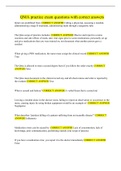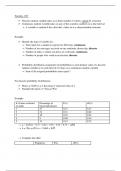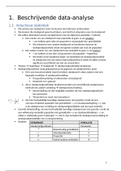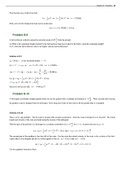Module 3
3.1.1
The structure of the periodic table
Elements are arranged:
- In order of increasing atomic (proton) number
- In groups which have the same number of electrons in their outer shell so have similar chemical properties
- In periods showing repeating trends in physical and chemical properties across different periods
(periodicity)
Periodic trend in electron configuration and ionisation energy
First ionisation energy is the energy required for the removal of 1 mol of electrons from 1 mol of gaseous
atoms, to form one mole of gaseous 1+ ions
Factors affecting first ionisation energy:
- Nuclear attraction
- Electron shielding
- Nuclear charge
- Atomic radius
The trend in first ionisation energy across periods 2 and 3: Generally, increases due to:
- Increase in nuclear charge as the number of protons increases
- Decrease in atomic radius as outer electrons are closer to the nucleus
- Electrons are added to the same shell so similar/same shielding
- This results in an increase in nuclear attraction on the outer electrons
- There are small decreases in first ionisation energy between elements such as Be and B as a result of s-
and p- sub-shell energies because the Be electron is removed from the 2s sub-shell and the B electron is
removed from the 2p subshell and the B electron has a higher energy because 2p has higher energy than
2s, therefore the 2p electron is easier to remove
- Another small decrease is due to p-orbital repulsion (e.g. between N and O) because the electron in O is
repelled by the electron which it shares the orbital with (electron in box diagrams), therefore Oxygen has a
lower ionisation energy than N, because the electrons in N occupy individual orbitals and are unpaired
electrons so there is no repulsion. In O, because the paired electrons repel one another, one of the paired
electrons is lost more easily than one of the unpaired electrons in N, thus O has a lower first ionisation
energy
The trend in first ionisation energy down a group: decreases due to:
- Increase in atomic radius as there are more shells
- Increased shielding because there is more electron repulsion from inner shells
- This results in a decrease in nuclear attraction on the outer electrons because the increased shielding
outweighs the increased nuclear charge
Successive ionisation energy increases with an increase in the ionisation number because as each electron is
lost, there is the same number of protons attracting fewer electrons (protons: electron ratio is greater in the
ions with a greater charge) and radius decreases as ions become smaller, increasing the attraction between the
nucleus and remaining electrons
- First ionisation energy: X (g) →X + (g) + e-
- Second ionisation energy: X+ (g) →X 2+ (g) + e-
Successive ionisation energies can be used to predict the number of electrons in each shell of an atom and the
group of an element
- A large increase in ionisation energy indicates that the next electron is being removed from a different
shell, closer to the nucleus and with less shielding so greater nuclear attraction. For successive ionisation
energies, the greater the charge of an ion, the smaller it is as the outer electrons in the ion are closer to the
nucleus
Periodic trend in structure and melting point
, Metallic bonding is a strong electrostatic attraction between positive ions (cations) and delocalised electrons
and all metal atoms form a giant metallic lattice structure.
When drawing a diagram to represent metallic bonding, the lattice must have at least two rows of positive ions
and a regular arrangement of the + ions and scattering of labelled delocalised electrons. If a metal ion is
shown, it must have the correct charge (E.g. Mg2+)
Some non-metals can form solid giant covalent lattices which are networks of atoms bonded by strong
covalent bonds e.g. Carbon and Silicon (and Boron). Lattices of carbon include:
- Diamond and Silicon: Form giant 3D structures with atoms bonded in a
tetrahedral arrangement
- Graphite: Forms a giant planar structure with many parallel planes weakly held
together and contains hexagonally arranged carbon atoms and the layers are
bonded by weak London forces, hence why it is soft as the layers can slide over
each other
- Graphene: Is a single layer of graphite and is composed of hexagonally
arranged atoms linked by strong covalent bonds
Macroscopic properties of giant metallic and giant covalent lattices:
Physical Properties Giant Covalent Lattices Giant Metallic Lattice
Melting and Very high because of the strong covalent bonds High because of the strong metallic bonds,
Boiling Points between atoms, therefore a lot of energy is therefore a lot of energy is required to break
required to break the bonds the bonds. Metals with more outer electrons,
which would be delocalised, have a higher
melting point because the metal ions would
have a greater positive charge, so the metal
would have greater attraction between ions
and delocalised electrons, therefore melting
points increase across a period. Generally,
melting point of metals decreases down a
group because as you go down, the delocalised
electrons are further away from the
cations/nucleus and the cations are bigger
because the number of shells increase,
therefore there would be weaker attraction
between cations and the delocalised electrons,
therefore weaker metallic bonding
Electrical Are non-conductors of electricity as there are no Metals are good conductors and can conduct
Conductivity mobile charge carriers/ions/electrons. electricity in both solid and liquid states due to
The only exceptions are graphene and graphite as the presence of delocalised electrons which
the bonding in the hexagonal layers only uses can move through the structure
three of Carbon’s four outer shell electrons and
the spare electron is therefore delocalised, so it
can conduct electricity. This gives graphite and
graphene a trigonal planar shape and diamond and
silicon a tetrahedral shape. In diamond and
silicon, all four outer shell electrons are involved
in covalent bonding, so there are no delocalised
electrons available for conducting.
Solubility Insoluble in most solvents. The covalent bonds Metals do not dissolve as any interactions
holding together the atoms in the lattice are too would lead to a reaction rather than dissolving
strong to be broken by attraction with solvents
There is variation of melting points across periods 2 and 3, due to structure and bonding. The melting point
increases from Group 1 to Group 14 (4). There is a
sharp decrease in melting point between group 14 (4)
and group 15 (5) and this sharp decrease marks a
change from giant to simple molecular structures. On
melting, giant structures have stronger forces to
overcome so have higher melting points, whereas
simple molecular structures have weak forces to
3.1.1
The structure of the periodic table
Elements are arranged:
- In order of increasing atomic (proton) number
- In groups which have the same number of electrons in their outer shell so have similar chemical properties
- In periods showing repeating trends in physical and chemical properties across different periods
(periodicity)
Periodic trend in electron configuration and ionisation energy
First ionisation energy is the energy required for the removal of 1 mol of electrons from 1 mol of gaseous
atoms, to form one mole of gaseous 1+ ions
Factors affecting first ionisation energy:
- Nuclear attraction
- Electron shielding
- Nuclear charge
- Atomic radius
The trend in first ionisation energy across periods 2 and 3: Generally, increases due to:
- Increase in nuclear charge as the number of protons increases
- Decrease in atomic radius as outer electrons are closer to the nucleus
- Electrons are added to the same shell so similar/same shielding
- This results in an increase in nuclear attraction on the outer electrons
- There are small decreases in first ionisation energy between elements such as Be and B as a result of s-
and p- sub-shell energies because the Be electron is removed from the 2s sub-shell and the B electron is
removed from the 2p subshell and the B electron has a higher energy because 2p has higher energy than
2s, therefore the 2p electron is easier to remove
- Another small decrease is due to p-orbital repulsion (e.g. between N and O) because the electron in O is
repelled by the electron which it shares the orbital with (electron in box diagrams), therefore Oxygen has a
lower ionisation energy than N, because the electrons in N occupy individual orbitals and are unpaired
electrons so there is no repulsion. In O, because the paired electrons repel one another, one of the paired
electrons is lost more easily than one of the unpaired electrons in N, thus O has a lower first ionisation
energy
The trend in first ionisation energy down a group: decreases due to:
- Increase in atomic radius as there are more shells
- Increased shielding because there is more electron repulsion from inner shells
- This results in a decrease in nuclear attraction on the outer electrons because the increased shielding
outweighs the increased nuclear charge
Successive ionisation energy increases with an increase in the ionisation number because as each electron is
lost, there is the same number of protons attracting fewer electrons (protons: electron ratio is greater in the
ions with a greater charge) and radius decreases as ions become smaller, increasing the attraction between the
nucleus and remaining electrons
- First ionisation energy: X (g) →X + (g) + e-
- Second ionisation energy: X+ (g) →X 2+ (g) + e-
Successive ionisation energies can be used to predict the number of electrons in each shell of an atom and the
group of an element
- A large increase in ionisation energy indicates that the next electron is being removed from a different
shell, closer to the nucleus and with less shielding so greater nuclear attraction. For successive ionisation
energies, the greater the charge of an ion, the smaller it is as the outer electrons in the ion are closer to the
nucleus
Periodic trend in structure and melting point
, Metallic bonding is a strong electrostatic attraction between positive ions (cations) and delocalised electrons
and all metal atoms form a giant metallic lattice structure.
When drawing a diagram to represent metallic bonding, the lattice must have at least two rows of positive ions
and a regular arrangement of the + ions and scattering of labelled delocalised electrons. If a metal ion is
shown, it must have the correct charge (E.g. Mg2+)
Some non-metals can form solid giant covalent lattices which are networks of atoms bonded by strong
covalent bonds e.g. Carbon and Silicon (and Boron). Lattices of carbon include:
- Diamond and Silicon: Form giant 3D structures with atoms bonded in a
tetrahedral arrangement
- Graphite: Forms a giant planar structure with many parallel planes weakly held
together and contains hexagonally arranged carbon atoms and the layers are
bonded by weak London forces, hence why it is soft as the layers can slide over
each other
- Graphene: Is a single layer of graphite and is composed of hexagonally
arranged atoms linked by strong covalent bonds
Macroscopic properties of giant metallic and giant covalent lattices:
Physical Properties Giant Covalent Lattices Giant Metallic Lattice
Melting and Very high because of the strong covalent bonds High because of the strong metallic bonds,
Boiling Points between atoms, therefore a lot of energy is therefore a lot of energy is required to break
required to break the bonds the bonds. Metals with more outer electrons,
which would be delocalised, have a higher
melting point because the metal ions would
have a greater positive charge, so the metal
would have greater attraction between ions
and delocalised electrons, therefore melting
points increase across a period. Generally,
melting point of metals decreases down a
group because as you go down, the delocalised
electrons are further away from the
cations/nucleus and the cations are bigger
because the number of shells increase,
therefore there would be weaker attraction
between cations and the delocalised electrons,
therefore weaker metallic bonding
Electrical Are non-conductors of electricity as there are no Metals are good conductors and can conduct
Conductivity mobile charge carriers/ions/electrons. electricity in both solid and liquid states due to
The only exceptions are graphene and graphite as the presence of delocalised electrons which
the bonding in the hexagonal layers only uses can move through the structure
three of Carbon’s four outer shell electrons and
the spare electron is therefore delocalised, so it
can conduct electricity. This gives graphite and
graphene a trigonal planar shape and diamond and
silicon a tetrahedral shape. In diamond and
silicon, all four outer shell electrons are involved
in covalent bonding, so there are no delocalised
electrons available for conducting.
Solubility Insoluble in most solvents. The covalent bonds Metals do not dissolve as any interactions
holding together the atoms in the lattice are too would lead to a reaction rather than dissolving
strong to be broken by attraction with solvents
There is variation of melting points across periods 2 and 3, due to structure and bonding. The melting point
increases from Group 1 to Group 14 (4). There is a
sharp decrease in melting point between group 14 (4)
and group 15 (5) and this sharp decrease marks a
change from giant to simple molecular structures. On
melting, giant structures have stronger forces to
overcome so have higher melting points, whereas
simple molecular structures have weak forces to












